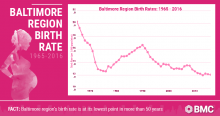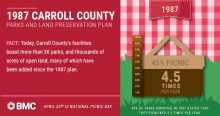Flowers, brunches and greeting cards full of loving messages are just a few of the ways that we celebrated the mothers in our lives on Sunday, May 13. Thanks for all that you do, moms - you’re awesome! Those packed brunch spots and ransacked floral departments at our local grocery stores caused us to pause and think though - there are a lot of mothers in the Baltimore region, and a lot of mothers mean that there have been a lot of births. So we dug into some data from the Maryland Department of Health and Mental Hygiene and examined the birth rate* in each of the Baltimore region’s seven jurisdictions and the state from 1965 through 2016. What we found was that the Baltimore region’s birth rate is at its lowest point in more than 50 years. This information shouldn’t be surprising, given the increase in females in the workforce, increased use of contraception and cost of living during the last 50 years. In 1965, the Baltimore region’s birth rate was 20.3, while the state’s was 20.9. In 2016, both rates were 12.1. As we continued to analyze the data, we saw that while slightly lower, the region’s birth rate is very similar to that of the state over time. What is notable is when the birth rate takes a sudden hit. Both annual births and birth rates in the Baltimore region declined from the beginning of Generation X in 1965 through the mid-1970s. But then the average birth rate declined drastically from 14.0 in 1972 to 12.6 in 1976. In Queen Anne’s County, the birth rate dropped as low as 9.9 in 1974. What’s interesting about this four-year period is that the birth rate dropped just as the U.S. felt the effects of the 1973 oil crisis and economic recession. It then slowly increased to 13.4 in 1977, and continued to steadily climb through 1990. Baltimore City, in particular, saw its birth rate peak at 19.5, or 2.8 points above the region’s average, in 1990. A similar pattern emerged as the U.S. dipped into the Great Recession after the 2007 subprime mortgage crisis. In the Baltimore region, the average birth rate was 13.5 in 2008, before dropping to 12.9 in 2009. However, Carroll County’s birth rate hovered between 9.2 and 9.6 from 2009 to 2014. So while the Baltimore region’s birth rate remains 1.67 times lower than 50 years ago, a dip in the economy could send it slightly further south. Can we please agree to continue buying those flowers, brunches and greeting cards to do our part in keeping the economy strong? *The birth rate is calculated at the number of births per 1,000 people. Sources: Maryland Department of Health and Mental Hygiene https://www.cia.gov/library/publications/the-world-factbook/rankorder/2054rank.html
American Community Survey - 1216 Work Out Of County Region.pdf
American Community Survey - 1216 Work Out Of County Region.pdf
American Community Survey - 1216 Work Out Of County QACO.pdf
American Community Survey - 1216 Work Out Of County QACO.pdf
American Community Survey - 1216 Work Out Of County HOCO.pdf
American Community Survey - 1216 Work Out Of County HOCO.pdf
American Community Survey - 1216 Work Out Of County HACO.pdf
American Community Survey - 1216 Work Out Of County HACO.pdf
You weekend warriors are in good company if – now that spring finally has sprung - you find yourself grabbing a basket full of food, soft blanket and Frisbee to head to your local park. April 23, is National Picnic Day, after all. In the Baltimore region, Carroll County is – and has been - the spot for some quality picnicking. The county planned it that way back in the late 1980s. The 1987 Carroll County Parks and Land Preservation Plan, which we found in the Regional Information Center, shows that 45 percent of survey respondents reported picnicking an average of 4.5 times a year. As a result, the plan also predicted that interest in picnicking would hold steady throughout the 1990s and into the Millennium. Carroll County’s parks and recreation areas, with 810 existing facilities, had more than enough space to accommodate the needs of the pastorally-inclined, according to the plan. Park-goers could enjoy most of that space without intrusion by other parties, too. By 1995, the plan anticipated that only 535 of its facilities would be occupied by multiple parties at a time. However, picnics hardly were the only outdoor activities that drew people to Carroll County’s facilities. Off-road vehicles - such as ATVs, dirt bikes, and modified trucks and jeeps - were on the rise in popularity, as well as organized sports. In short, they needed acres of more space. By 1987, Carroll County had limited space for off-roading, and according to their models, it would need 70.5 miles of track by 1995. Plus, the county anticipated that it should construct 46 more baseball fields, 4.5 acres of swimming pools, and 67 more basketball courts. Carroll County’s facilities currently boast more than 30 parks, and thousands of acres of open land, many of which have been added since the 1987 plan. These facilities include picnic areas, trails, hunting and fishing space, playgrounds, tennis and basketball courts, and baseball, softball and multipurpose fields.
Source: Greenhorne and O’Mara, Inc. 1987. Carroll County Parks and Land Preservation Plan, 1986-1987.
American Community Survey - 1216 Work Out Of County CACO.pdf
American Community Survey - 1216 Work Out Of County CACO.pdf
American Community Survey - 1216 Work Out Of County BACO.pdf
American Community Survey - 1216 Work Out Of County BACO.pdf
American Community Survey - 1216 Work Out Of County BACity.pdf
American Community Survey - 1216 Work Out Of County BACity.pdf
American Community Survey - 1216 Work Out Of County AACO.pdf
American Community Survey - 1216 Work Out Of County AACO.pdf


